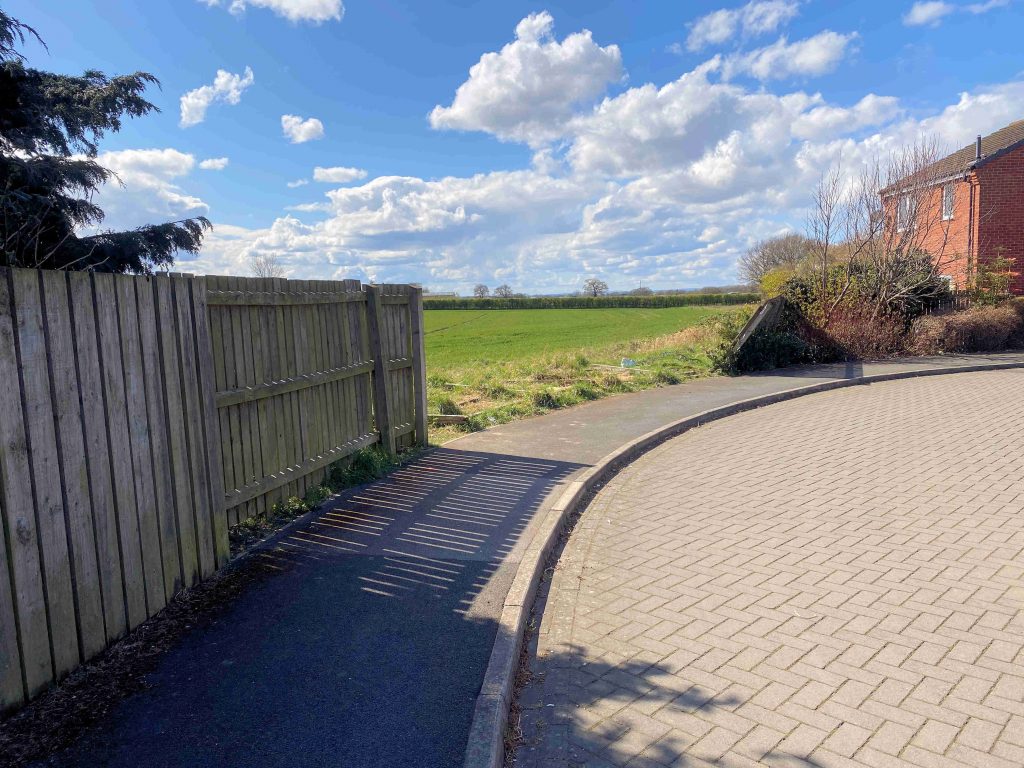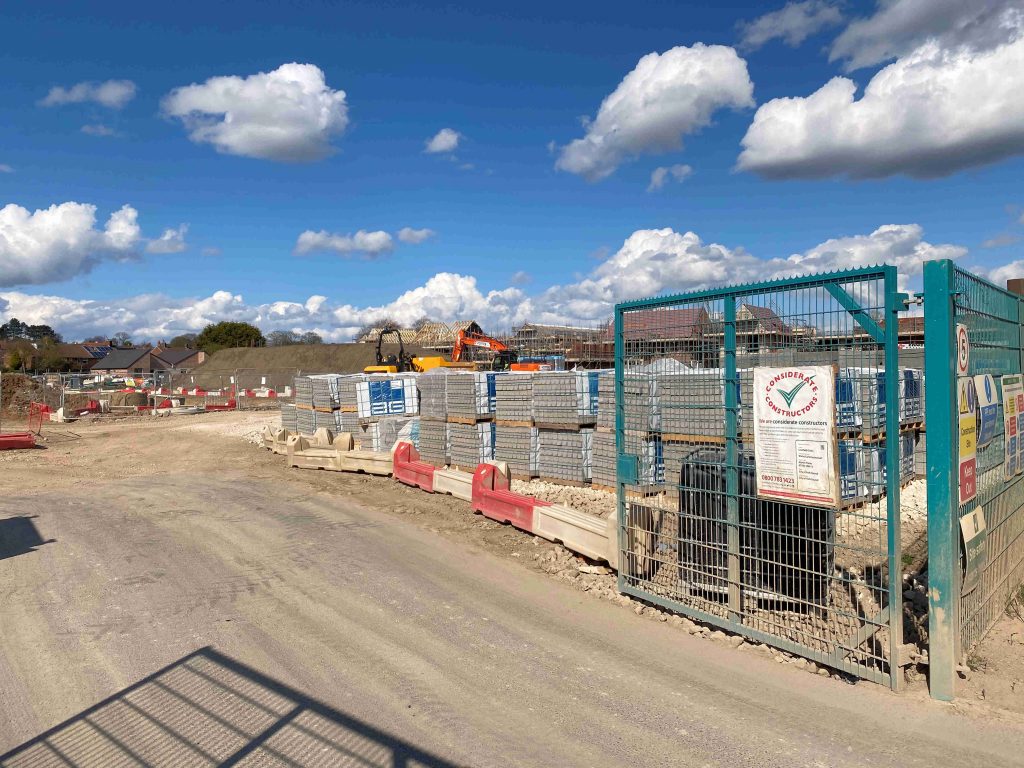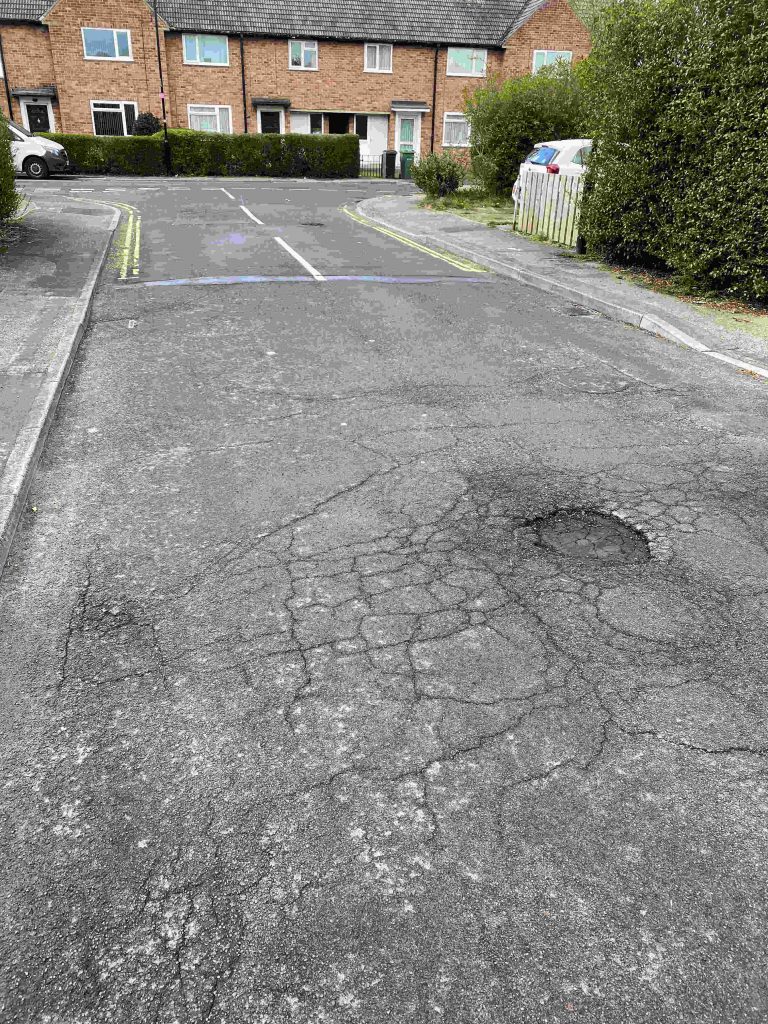
Potholes on Ashford Place 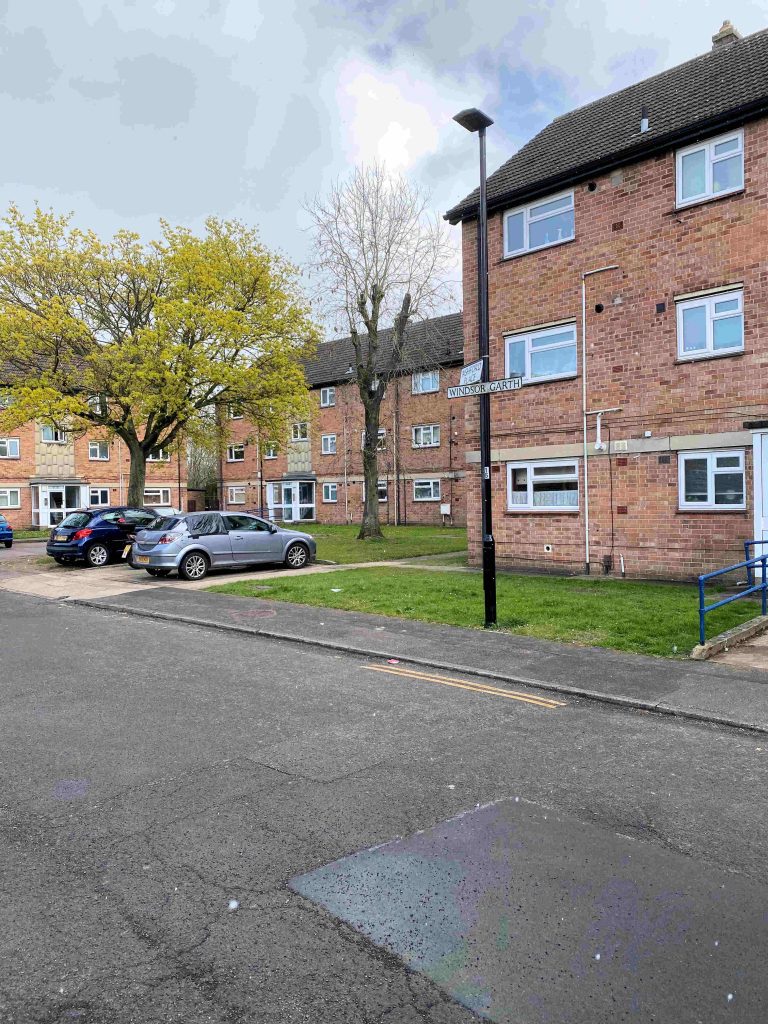
Misaligned street sign Ashford Place /Windsor Garth
Council failed to monitor key aspect of Groves traffic scheme
After several attempts, responses to Freedom of Information (FOI) requests have confirmed that the Council had not established key base line data measurements before implementing The Groves traffic ban in the summer.

Although never formalised, those favouring the changes argued that rerouting “through traffic” onto neighbouring roads would;
- improve air quality
- reduce traffic levels and thereby accident numbers
- make the area “quieter”
- encourage cycling/walking
- utilise time limited central government funding grants
At the time of the decision to press ahead with the scheme (June 2020), the area had been virtually traffic free for 3 months because of the lockdown restrictions.
One of the consequences of lower economic activity has been greatly reduced pollution levels during 2020. The table below shows the current situation.

No noise measurements have been published, for streets within The Groves area, by the Council.
A response to an FOI request a few months ago revealed that accident levels have been very low within The Groves area during the last 3 years.
The Council has admitted that it doesn’t have any base line air quality measurements for the streets within The Groves area. Nor, apparently, is it monitoring current pollutions levels there (although, like the rest of the City, these are likely to be very low – see above).
The Council is also being very coy about what traffic volume information it holds. Traffic flow information for 2019 – when the plans were first discussed – should, in our view, have been published.
Similar benchmark information for June 2020 (post pandemic) should also have been published to inform decisions at that time.
Such figures as have been made public concentrate on the capacity of the nearby diversionary routes.
The Council is refusing to release information about movements within the Groves area raising, at least, a suspicion that it hadn’t completed counts. It now says that it will release information in June 2021.
The most concerning aspect of this whole process has been the lack of any safety audits. The Council has promised that a stage 3 audit will be completed. But it doesn’t say when.
In the meantime the hazards – particularly for cyclists – remain and will grow as movements return to more normal patterns.

We could use the FOI appeal processes to try to force the Council to publish the details it holds on internal modal travel patterns for the periods before the traffic ban was introduced.
It would have no practical effect unless backbench Councillors were prepared to challenge the system. This they don’t seem to be prepared to do.
We must just hope that some of the more perverse aspects of the scheme don’t lead to more avoidable accidents during the run up to next years review.
No safety audit completed on Groves traffic scheme
Contrary to claims made on social media a few months ago, a response to a Freedom of Information request has revealed that no road safety audits were completed on The Groves road layout changes before they were introduced in the summer.
Safety audits area mandatory for changes to highway layouts. Their purpose can be viewed by clicking this link
It is without precedent in York, for a scheme of this size to be implemented without the Stage 1, 2 and 3 audits being completed.
It is of no relevance that the scheme may have been labelled as “experimental” by Council officials.
It appears that a Stage 3 (post construction) audit will be undertaken when changes to the layout have been completed. It is unclear when this will happen and what changes may be planned*.
The revelation is the most serious of several concerns highlighted by the Councils refusal to respond fully to the request for information. In due course, this may be explored further with the Information Commissioner, but the safety aspect (including the controversial unsegregated contraflow cycle lanes) may require action from Grant Shapps the Transport Minister who has been scathing about the quality of some “emergency” traffic changes introduced post COVID. The Groves scheme was funded from the governments “emergency transport budget”

The Groves scheme was designed in late 2019 and so preceded the start of the pandemic.
The response also raises the question of just what the scheme was intended to achieve?
Most commentators have pointed to improvements in air quality. However, air quality across the whole highway network in York has been good since the start of February and the Council has been unable to produce any figures suggesting that The Groves is any different in that respect.
Some said that there would be fewer collisions. Accident data – mostly pre lockdown – reveals that there were no severe accidents in The Groves area and that there were no accidents at all involving children. The severe collisions that were recorded happened on the alternative route for traffic (Clarence Street, Lord Mayors Walk, Monkgate) with most at the road junctions which are still open to traffic. Thus, the scheme may actually have increased risks on the network as a whole.
The Council has refused to reveal the pre and post implementation traffic levels in the area. There is absolutely no reason why the 2019 base figures should not be in the public domain. The Council instead promise to include the figures as part of a public review of the scheme during the first quarter of 2021.
With traffic levels currently running at about 80% of pre COVID levels, we are not expecting to see a significant impact on congestion levels on alternative routes.
The removal of “through traffic” from The Groves will offer residents who live there a quieter lifestyle. Whether it is safer or less polluted may now be open to question.
The type of closure chosen and its impact on emergency services, deliveries and local businesses has been subject to criticism
There is no good reason for the York Council to be so secretive about the scheme and it is downright irresponsible to include elements which increase hazards for road users without undertaking, transparent, risk assessments.

- The Council has now published the changes it is making. They are;
a. Change the position of the road closure on St. John’s Crescent, to relocate it at the junction with Garden Street. Removable bollards will be installed for part of the closure to provide a secondary emergency access route to streets off Garden Street/St John Street;
b. Remove 2.4m of on street parking on St John Street (both side) near the junction with Garden Street to facilitate turning movements at the junction;
c. Change the position of the road closure in place at the junction between Neville Terrace, Park Grove and Brownlow Street, to address issues with some drivers using the alleyways between Neville Terrace, Eldon Terrace and Amber Street to bypass the closures;
d. Remove the parking bay adjacent to 25 Neville Terrace to facilitate access and egress for larger vehicles, including emergency vehicles.
2. Approve a Temporary Traffic Regulation Order (TTRO) to waive Pay & Display charges for parking areas near the shops on Lowther Street and adjacent to the local shop on Townend Street (between Abbot Street and Del Pyke) for a duration of 6 months.
Changes published by York Council on 20th October 2020
No rent paid for 5 years on Container Village
According to a local community blog published in Brixton, London, the local version of the “container village” hasn’t paid any rent to the Lambeth Council for 5 years.
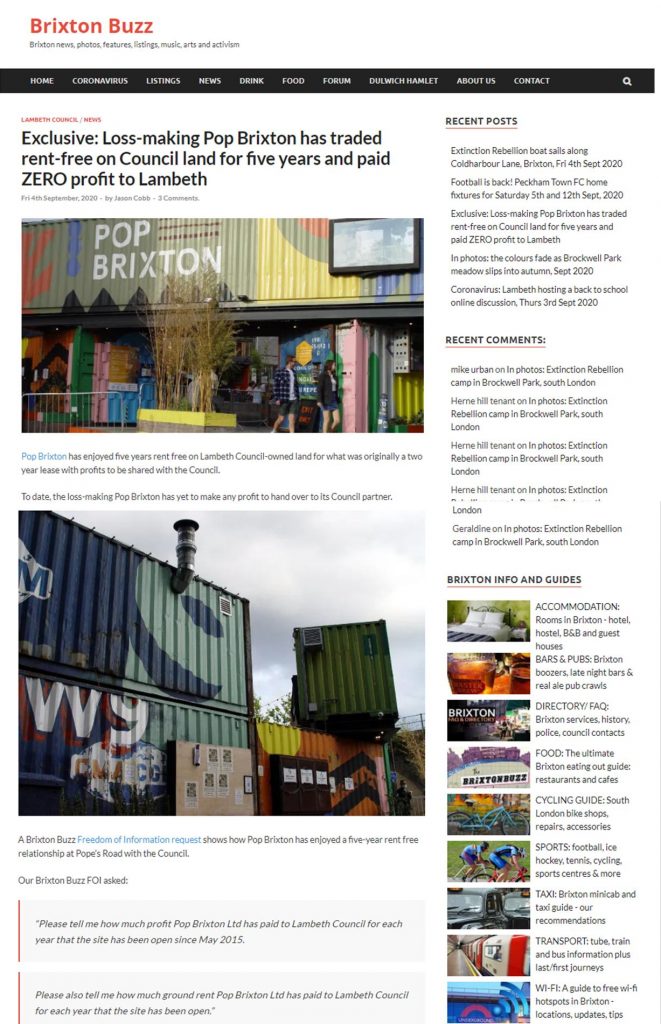
“Pop Brixton” was used as a paradigm when the York Spark owners were trying to persuade the York Council and its planning committee that siting shipping containers in a conservation area was a good idea.
Like Brixton, the operators offered to rent the Piccadilly site from the Council and to share in the ventures profits.
An FOI response to the “Brixton Buzz“ has revealed that a similar deal there produced no income for the local authority.
Now, like in York, monthly rental payments are being sought by Lambeth Council.
A Freedom of Information request was submitted to the York Council on 25th August asking the authority to confirm that the terms of a new lease – agreed in February – have been fulfilled by the site occupiers.
Spark operated on a “tenancy at will” basis earlier in the summer following its closure during the health crisis. Its original lease expired on 1st July 2020

Spy camera fines increase in York

Some motorists may be in for a surprise according to the latest figures published by the York Council in response to a Freedom of Information request.
The number of drivers fined for access breaches on Coppergate and Low Poppleton Lane had, in the past, been published on the Councils web site.
These stopped abruptly last October.
Now a Freedom of Information request has revealed that the number of offenders caught fell to zero at both sites in January.

However, more recently – and despite “lock-down” – the numbers are on the rise again.
During May 268 drivers on Coppergate and 90 on Low Poppleton Lane fell foul of the cameras.
The Council hopes to receive around £1 million in fine income.
There was little justification for enforcing access restrictions during April and May.
Vehicle numbers – mainly used by key workers – on York streets were very low and those bus services which continued encountered no congestion.
York Council reveals number of littering and fly tipping fines issued
 The Council says that it only issued two Fixed Penalty Notices for littering during 2019.
The Council says that it only issued two Fixed Penalty Notices for littering during 2019.
13 Penalty Notices were issued for fly tipping.
The information comes from a response to a Freedom of Information request recorded in the “What do they know” web site.
W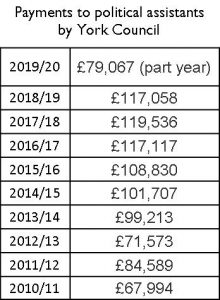 ith the Council now only updating its register of responses on its own web site every 6 months (and then with headline information only), the independent site is now the only way that residents can keep up to date with the claims being made by the York authority.
ith the Council now only updating its register of responses on its own web site every 6 months (and then with headline information only), the independent site is now the only way that residents can keep up to date with the claims being made by the York authority.
Cost of political advisers
The site also reveals the costs of providing “political advisers” for Council Groups.
The figures reveal that costs have almost doubled over the last decade
The advisers are supposed to undertake background policy research to assist Councillors in their duties.
The curtain of secrecy falls again at York Council

Those hoping for more transparency at the York Council under its new LibDem/Green leadership have been desperately disappointed this week.
First a failure to reform the system for granting early release resulted in a “behind closed doors” decision which could be costing taxpayers hundreds of thousands of pounds.
Now the Council has closed down direct access to the responses that it has made to Freedom of Information requests.
For over 10 years residents were able to browse “on line” what the Council had said in response to requests.
No more.
The responses have been removed from the Council web site and users must now search a “disclosure log“ before requesting copies of the responses.
There are hundreds of FOI and Environmental Information Regulations (EIR) requests made each year.

In most cases the issue titles used on the log – which is 6 months out of date – give little clue as to what has been asked. Much less could users second guess the answers.
Instead they must make an application for access to the source document.
In most cases we would expect that researchers would simply submit a new request.
At present the “What do they know” web site is unaffected https://www.whatdotheyknow.com/select_authority
The performance of the Council in responding to FOIs is poor. There is one current example – a request for copies of Service Level Agreements – which has been outstanding for over 4 months; well outside the performance target set by the Information Commissioner.
Ostensibly the Council has made the change to ensure that those with disabilities have the same opportunity to get information as the able bodied.
Unfortunately the Councils interpretation means that both sectors of the community will now share a common level of ignorance and inconvenience.
As a minimum the Council should put a link on its “register” to the actual documents. Web services such as “dropbox” make this very easy to do.
A parallel service for disabled uses should also be made available.
An iron curtain descends?
It seems that the York Council will stop publishing responses to Freedom of information requests on its web site.

In 2009 the York Council became one of the first in the country to allow on line public scrutiny of the responses to information requests.
We have been critical in the past about the speed of the Councils information responses.
This came to a head in 2014 when the Information Commissioner became involved. The then Labour controlled Council introduced a new web page which offered links to all FOI responses. The web page was immediately criticised as responses were not listed in chronological order and were grouped under, seemingly, random headings. There was no search facility.
Improvements were promised but never materialised.
Other independent web sites grew up which aimed to make getting and viewing information easier. The best known is probably https://www.whatdotheyknow.com/
Now a report to a meeting taking place on Wednesday suggests that some officials want to make access to information even more difficult.
They intend to replace the current listings with what they term a “disclosure log”. No example of what such a log might look like are provided.
The report quotes an EU decision taken in 2016. The equivalent UK legislation became effective on 20th September 2019. It was aimed at improving accessibility for people with disabilities.
This is being interpreted by officials as preventing the publication of information on the Council web site in PDF* or Word format.
*NB. There are many papers published on the Councils web site in PDF format including, ironically, the report being considered at Wednesday’s meeting!
Of concern, will be the implication that the FOI archive of decisions (going back 6 years) may no longer be easily accessible. This provides vital information for researchers. It also helps to avoid duplicate requests.
That, and loss of transparency on future responses, would be a major step backwards.
The report is for the “information” of the Council’s Audit and Governance” committee. They rightly should take a view on the issue but any decisions on obstructing public access to information must properly be made by the Councils Executive, following proper consultation
There is an provision in the legislation which allows an exemption for (historic) information translations where this would be an unreasonable burden on taxpayers.
The legislation does not cover third party web sites so information on https://www.whatdotheyknow.com/ should be unaffected.
Proper provision for disabled access can, and should, be made using, for example, a mirror site.
But this must not be at the expense of the amount of information released into the public domain.
Details of York Council football club loan published
A response to a Freedom of Information request has finally forced the Council to reveal the terms of its £350,000 loan to York City FC agreed in 2014.

The loan was secured by a legal charge on the Bootham Crescent ground.
The loan involved annual repayments of £35,000.
The balance of the loan is payable immediately if the Club sell Bootham Crescent. It is understood that a house builder still has an option to purchase the site when the football and rugby clubs move to the new LNER stadium in 2020.
In addition the Football Club has agreed to pay £2 million towards the cost of building the new stadium.
There is a legal charge on the club’s assets to cover this liability.
The Council continue to refuse to publish the valuations that they have undertaken on Bootham Crescent.
They also refuse to say how much rent they expect to receive from the football club at Monks Cross (the stadium part of the development is expected to cost around £16 million of the total £47 million cost of the whole development).
The council has confirmed that, once all processes have been complete, it intends to release the lease agreement with York City into the public domain.
York Council stops publishing Freedom of Information responses
The York Council has stopped publishing its responses to FOI requests on its web site.
For many years the authority made information publicly available on this web site https://www.york.gov.uk/info/20219/freedom_of_information/1535/freedom_of_information_responses

That practice stopped last summer although there was no consultation or publicity given to the change of policy.
The new LibDem administration has apparently gone along with this change of approach.
The Council is not required by law to publish responses but it is regarded as good practice. Most Councils do publish this information and it has the advantage of helping to discourage duplicate requests,
Some responses are published when a request has been submitted via the independent web site “What do they Know” However this is not the York Councils preferred channel for submitting and answering information requests.
It provides is own “on line” information request form (click)
The Council received 2068 requests under FOI and Environmental Information Regulations (EIR) during the last financial year
News blackout
The Council has also scrapped its “Ward News” web pages.

For many years the authority provided web pages which told local residents what was going on their local neighbourhoods. These were linked to background pages for each ward (click for example)
The pages typically carried “what’s on” lists and event posters. These have now been binned by the local authority.
The Council is also refusing to publish, on individual Residents Association web pages (example), details of their meetings. Copies of agendas and meeting minutes had been published by the Council for several years but,
in a recent decision, these have now been black-listed, ,
This seems to be part of a deliberate strategy aimed at reducing resident influence at West Offices. Half a dozen residents associations have been forced to disband in recent years while the overarching York Residents Federation was also ditched last year.
Liberal Democrat Councillors had previously promised more support for residents organisation.
Unfortunately things now seem to be getting worse rather than better.







